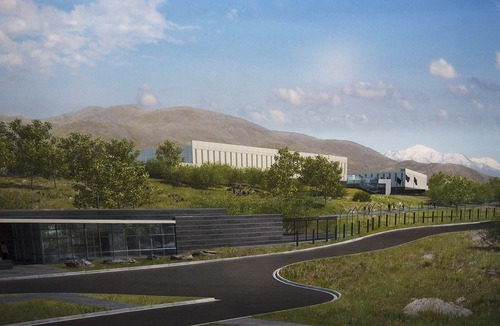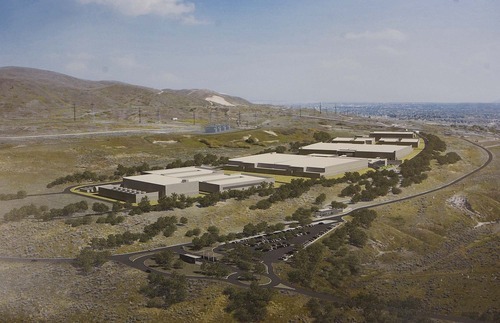This is an archived article that was published on sltrib.com in 2011, and information in the article may be outdated. It is provided only for personal research purposes and may not be reprinted.
Camp Williams • The creation of up to 10,000 construction jobs alone makes the Utah Data Center a great project for the state.
But speakers at Thursday's groundbreaking ceremony for the $1.5 billion facility emphasized that, economic benefits aside, the center solidifies Utah's position as a leading defender of the American way of life.
"The threat posed by computer hackers is very real and growing," said Sen. Orrin Hatch, R-Utah, to more than 200 participants at the event commemorating the start of construction on the computerized center that will help U.S. intelligence agencies combat cybersecurity threats.
"This country defends itself against cyberattacks every day. It's an arena where we need to defend ourselves," he added. "This center will support the effort to better understand that threat."
As Maj. Gen. Brian Tarbet, head of the Utah National Guard, put it: "This will be an important link in intelligence and defense systems to find, fix and kill enemies and to protect American citizens."
The facility, scheduled for completion in October 2013, will occupy 1 million square feet of space on 240 acres of Camp Williams' property on the Salt Lake-Utah county line.
Its nerve center will be 100,000 square feet of climate-controlled computer space, where U.S. intelligence agencies will collect information that will be used to protect national security networks and help the U.S. Department of Homeland Security provide warnings about cybersecurity threats.
Accomplishing that on an accelerated timetable requires a massive investment in infrastructure — everything from the 65 megawatts of electricity needed for the computers and their cooling systems to the perimeter security system that will protect the facility from attack.
Anywhere from 5,000 to 10,000 people — most of them Utahns — are expected to be employed in the undertaking. And when the job is done, 100 to 200 highly skilled experts will remain on site to keep the center operating.
"These are the kinds of jobs and people you want in this area," said Charles Fisher, a retired Farmington resident. Fisher attended the ceremony with his wife, Joyce, because of a lifelong interest in national security that stems from past work on military projects — some at Hill Air Force Base. "This is the best thing that's happened to the state."
Gary Pace hopes the project turns out to be good for his company, Salt Lake City-based Certified Handling Systems, which supplies shelving and other materials used in the installation of computer systems.
"This is a pretty big deal. I just wanted to see what was going on," he said, adding that while he has yet to catch on as a subcontractor for the main construction firms (including Salt Lake City's Big-D Construction), "I'm still in the game."
Dressed in everyday work clothes, Fisher and Pace stood out from the rest of the audience — mostly men in suits representing the government agencies and major contractors involved in the project, or men in military khakis representing the Utah National Guard or the Army Corps of Engineers, which is overseeing the facility's construction.
Tarbet said his facility was selected as the Utah Data Center site because, "Utah and Camp Williams made the best case for taxpayers to put it here," a boast validated later by Brig. Gen. Peter "Duke" DeLuca of the Corps of Engineers. He said that while there are "at least 50 perfect states to build a data center," Utah won based on results of a selection process that evaluated 130 different factors.
One was particularly critical, said National Security Agency Deputy Director John Inglis.
"Utah, to the NSA, is a handshake state," he said, explaining that while it is important to tie details down with contracts, "In Utah, you know the person on the other side of a handshake will deliver what is promised."
Lucrative contracts
The U.S. Army Corps of Engineers has awarded several contracts so far to develop the $1.5 billion Utah Data Center at Camp Williams
• Main construction contract to the joint venture of Balfour Beatty/DPR/ Big-D Construction — $1.2 billion
• Initial earthwork to Kiewit Federal Group, Inc. — About $50 million
• Electrical substations to Kiewit — About $25 million
• Planning, design and construction of utility infrastructure (power, water, sewer) to Utah Military Installation Development Authority (MIDA) — Up to $70 million
• MIDA has provided subcontracts for infrastructure design to Bluffdale City, Stantec, Rocky Mountain Power and Wasatch Electric









